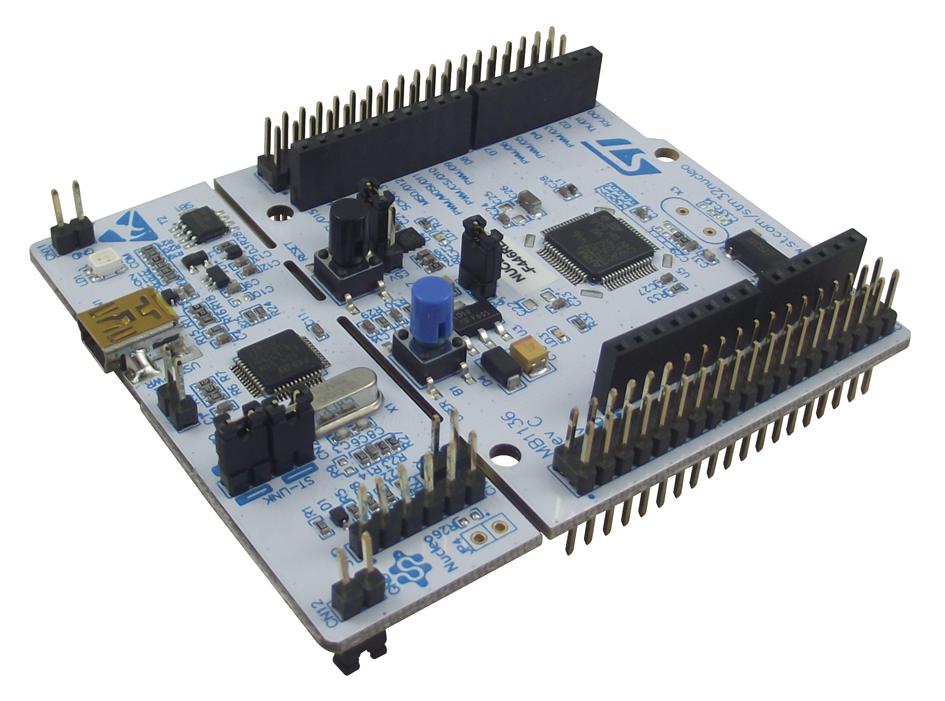
- #NUCLEO F446RE I2C PINS HOW TO#
- #NUCLEO F446RE I2C PINS UPDATE#
- #NUCLEO F446RE I2C PINS FULL#
- #NUCLEO F446RE I2C PINS CODE#
That would solve several problems with the current implementation. I also propose to modify the ic2.start API to include the slaveaddress as parameter. They may still be useful in some cases, but at least the documentation should be improved to understand all limitations. Some people propose to get rid of the byte operations completely. You should therefor use the I2C blockwrite operations instead of the byte operations unless you have done serious testing first. STM32 Nucleo-64 development board with STM32F446RE MCU, supports Arduino and ST morpho connectivity. This does not match with the mbed I2C API. The STM32F446 product line provides from 256-Kbyte to 512-Kbyte Flash, 128-Kbyte SRAM and from 64 to 144 pins in packages as small as 3.85 x 3.728 mm. You should first load the dataregister with the slave address, then generate the start and send the slaveaddress in one operation. The NXP lpc8xx I2C engine for example can not really generate a separate start condition followed by a separate write for the slaveaddress. The byte operations work fine on the original NXP lpc1768, lpc11u24, but not or at least not reliably on later NXP platforms and on several other platforms. The easiest way to program the board is to use OpenOCD. This is mainly due to the way the I2C engines have been implemented. The ST Nucleo-F446RE board includes an on-board ST-LINK V2 programmer. If you wish to use say SPI or I2C interfaces then you are required to use only the pins shown in the datasheet for your NUCLEO board so that the compiler can arrange the requested hardware functions onto the specific pins - that is mandatory.Unfortunately a lot of mbed platforms have problems with the i2c.start, i2c.stop and i2c byte write and byte read operations. Do respective the max voltage ranges (most pins are 5 volt tolerant but play it safe and consider to use 0 to +3V3 for most of your experiments. We'll use the I2C protocol to send and receive messages with a TI. The use of such port pins as I/O (Input / Output) is very straightforward using the MBED library. Let's take our STM32 to the next level and communicate with a sensor.
#NUCLEO F446RE I2C PINS CODE#
Soon you will learn how easily MBED shelters us from the many lines of complex code to achieve the desired tasks. This should now flash the PC_8 pin on your Nucleo board.ĭo try the example and notes and certainly post back if you have any issues. you could also reverse the LED and connect the ANODE to your local +3.3 volts but then to turn the LED ON, you will needĬompile -> drag & drop the binary onto the target drive letter. with this wiring when PC_8 = 1, you are applying +3.3 volts onto PC_8 which will then turn the LED ON and if 0, LED will be connect the ANODE (positive / long lead of the LED) to PC_8 and the CATHODE (negative / short lead) to ground
#NUCLEO F446RE I2C PINS FULL#
For a full pinout of the Nucleo-F446RE, refer to the pinout section on the mbed page. Note that most of the inner male pins are connected to the female pins in the Arduino UNO configuration. How, replace the LED1 value with a port pin that you wish to use from the NUCLEO MBED page for your target board:ĭigitalOut myled(PC_8) // attach a LED with a current limit resistor of 390 ohms or higher to the noted pin on NUCLEO Connect the wires to the male header pins on the Nucleo board as shown in the diagram. Until yestreday it worked normally I was trying to communicate wit a hcsr04 sensor (ultrasound proximity sensor) with i2c since it was supported and I definitely messed up the pin config (I believe so because thats the only logical explaination). Next, let us say you wish to change the LED1 pin to your custom defined port pin. Hi everyone, I have a problem with my nucleo f446re board. PB8 and PB9 pins turn green, indicating that weve fully configured the I2C.
#NUCLEO F446RE I2C PINS HOW TO#
This is important to be sure you upgrade to the latest library by MBED. Lets look at how to connect a simple I2C device to a STM32 Nucleo board to.

#NUCLEO F446RE I2C PINS UPDATE#
Be sure to select the MBED library inside this imported program and the select UPDATE using the right side of your compiler. You can review the Nucleo board details and assign a pin to be an output using the respective port pin name.įor example, IMPORT this quick demo (use the BLUE BUTTON on the right side of the screen once you land on the following webpage to import the quick demo into your cloud space account with MBED):īy default, if you select the target NUCLEO board that you presently own, the LED1 value will automatically map to a working LED supplied with your kit.

Then review the many examples on this website including the COOKBOOK and HANDBOOK webpages at the top of this website to assist you in learning quickly about the benefits of MBED. Review the schematics for your Nucleo board from the following link:Īlso suggest to review this quick summary of the pins available through the Nucleo board with your CPU: Please review the following landing page for your STM32F44RE Nucleo board:


 0 kommentar(er)
0 kommentar(er)
